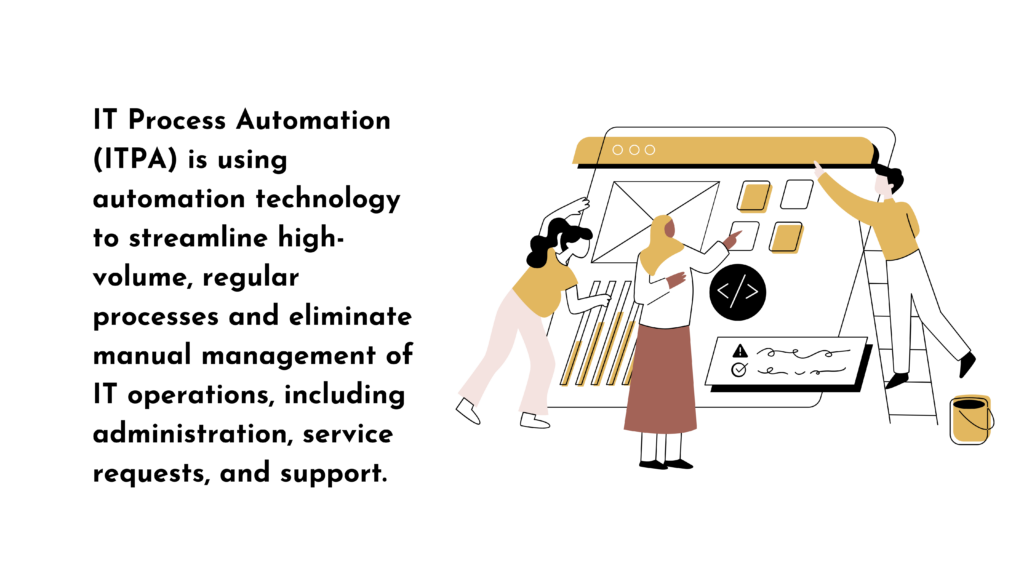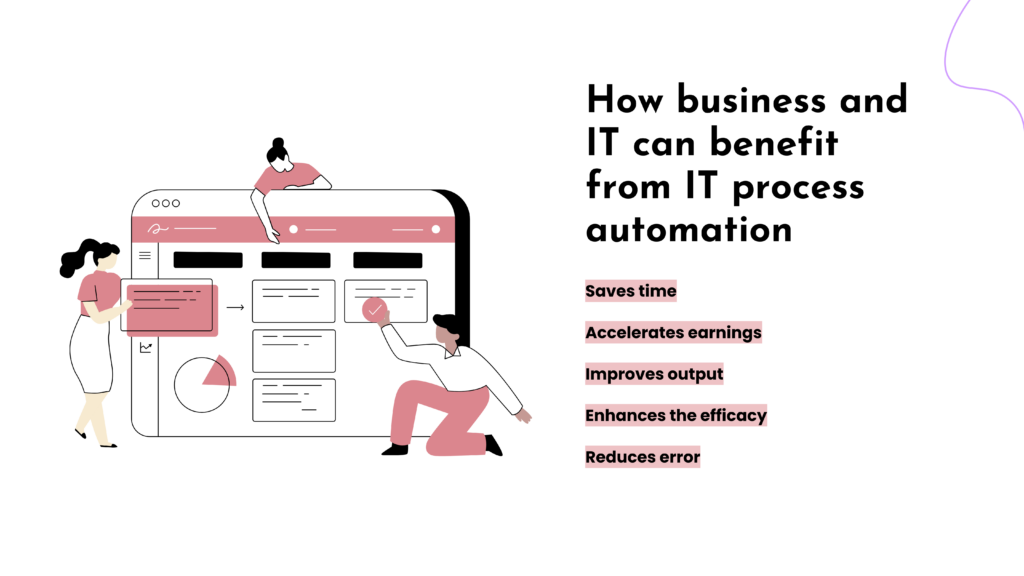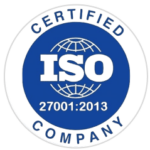IT process automation is on the fast track owing to the tremendous advancements in artificial intelligence (AI), robots, and business process management. According to Gartner, 69% of day-to-day managerial work will be entirely automated by 2024. The good news is automation is industry agnostic, meaning everyone can make the most of it.
This is excellent because, given the current market conditions, a company must be able to adapt quickly to new business models. It should have the tools to develop new products and services and use technology to stay competitive.
Investing in IT process automation is key to achieving this level of output. Eliminating repetitive manual tasks, resource optimization, and information control are critical to any business’s long-term success.
What is IT Process Automation?
IT Process Automation (ITPA) is using automation technology to streamline high-volume, regular processes and eliminate manual management of IT operations, including administration, service requests, and support.
Relieving the IT team’s workload of recurring duties is a crucial win IT process automation solutions offers and allows them to focus on business activities that provide value. For example, sending emails to a large group of recipients, checking in on status updates, handling service inquiries, or reminding employees to attend security or training sessions.

How Business and IT Can Benefit From IT Process Automation
Automation business processes remove any bottlenecks that waste time and resources. This leads to improved productivity, enhanced customer service, and performance and helps businesses achieve their goals efficiently.
Here are five ways business and IT can benefit from IT process automation.
1. Saves Time
Business process automation tools enable your team to focus on important tasks and work more efficiently. This time can be invested in critical thinking, strategizing, and adding personal touches to improve overall customer satisfaction.
2. Accelerates Earnings
While everyday tasks are crucial to your business operations, they aren’t the best use of your employees’ time. A tried and tested way to boost earnings is to let machines take care of routine jobs and have your team spend time finding ways to strategize and increase revenue.
3. Improves Output
Machines can complete numerous tasks simultaneously, speeding up operations and improving overall business productivity. Employees will complete more work at the same time if they use technology to assist with their jobs.
4. Enhances The Efficacy
Teams can address grueling activities with the help of IT process automation. Companies increase efficiency significantly by getting quicker outcomes and being more reliable at lower costs.
5. Reduces Error
Even the most qualified and skilled workers err. Your employees’ performance can be hampered by being distracted, forgetful, or multitasking, especially when doing repetitive, tedious tasks.
Computers, on the other hand, don’t have this issue. They also never get bored or fatigued, which greatly reduces the possibility of error for businesses.

IT Process Automation Examples
When it comes to automation and orchestration, the list of processes that can be handed to machines is almost endless. However, to give you a peek, here are three solid examples of processes that can be easily automated.
Google Workspace License Management
Find inactive users in your Google Workspace admin console, export them as a list for evaluation, and revoke Google Workspace licenses for the permitted users.
IT Service Desk Request
Automate your IT department’s service desk request process to manage priorities, monitor interactions, and gain insight into what’s going on under one roof! Put everything on autopilot, keep track of tickets’ progress using dashboards, free up your IT resources, and deliver superior customer service.
Learn how to automate Service desk requests with Jira in this guide.
Employee’s IT Asset Management
Easily automate end-to-end asset management of your team by giving employees the option to request IT equipment through a form. Observe the delivery of the device and any necessary communications, along with maintaining an asset allocation inventory. You can do this for both the onboarding and offboarding process.
Check out more IT process automation examples here.
The Top Three Trends of IT Process Automation
IT process automation is the future, and there are various trends to prove that. Listed below are three trends most relevant to businesses.
1. Adoption of Low-Code/No-Code (LCNC) is the future of IT Process Automation
LCNC development platforms have witnessed a sharp rise in popularity, especially in the post-pandemic era. Business users and developers now have the tools to create applications using simple drag-and-drop features in a visually integrated development environment (IDE).
Given the market’s skyrocketing growth and the lack of adequately skilled software developers, there’s little doubt that LCNC will continue to grow in popularity in the coming years.
2. IT Process Automation will start to become a catalyst for staff development
The future of employment and employee onboarding automation have been hot topics for a while now, especially employment.
People are concerned that IT process automation will make their roles redundant and lead to a rise in unemployment. However, the reality is automating regular tasks will only add more efficiency to the work environment. Humans will never be entirely replaced by robots.
3. Improving data quality and cleansing for better decision-making
Access to the correct data can change decision-making and the future of any business. However, assessing data quality gets challenging as the volume of said data increases dramatically.
Automation can easily manage large quantities of data and ensure the information you have is pure, consistent, and dependable at all time.
Why No-code is Your Choice
No-code development is a standard development cycle with one glaring advantage – you don’t have to write a single line of code.
That means you don’t need a team of expensive developers to create these automations for your business. You can do it yourself sitting in your basement.
Here are a few reasons why no-code makes for a great choice:
Greater Agility
Most of your development can be done using simple drag-and-drop pre-built modules and all of this contributes to an overall reduction in development time.
Lower Cost
You save cost in two critical areas:
- You don’t have to invest in a highly qualified team of software developers.
- No code saves you time and resources, which lowers overall business expenses.
Enhanced Efficiency
The IT team is no longer bombarded with regular requests because a lot of regular requests have become much more manageable. Work that would take months can now be done in a matter of hours or days.
Simple to Modify
With the traditional approach, modifying a functionality can be challenging, primarily if the code is written in a language you don’t understand. With no code, you can replace and update things much more quickly.
Essential Features to Look At When Choosing IT Process Automation Tools
As you work on compiling a list of automation tools to test for your business, check them for the following six factors:
Clean interface – Look for automation tools with user-friendly interfaces. Automation should be simple to construct and test using drag and drop or visual modeling.
Strong integrations – Process automation should be possible across all of the programs you use at work, including email, Slack, and other tools to give you a seamless experience.
Option to reuse – Automation truly makes sense when it helps all ongoing and future projects. So, search for tools that let you store and use automated workflows again as required.
Simple maintenance – The program must give your failure logs so that any script error can be quickly determined and fixed. Simple maintenance brings you one step closer to successful, long-lasting automation.
Pricing – Is the automation software really worth the price? Think about the product price as well as potential future expenses such as service fees, upgrades, and add-ons for compatibility.
IT Process Automation Is The Future of Business
According to a PWC survey conducted in 2021, 61% of people worldwide think that automation is endangering people’s jobs. The reality is that automation is changing roles rather than eliminating employment prospects.
The role of automation is to take care of the jobs that computers can accomplish better than us, removing human error and enabling scalability. Learn how to automate Service desk requests with Jira in this guide.





